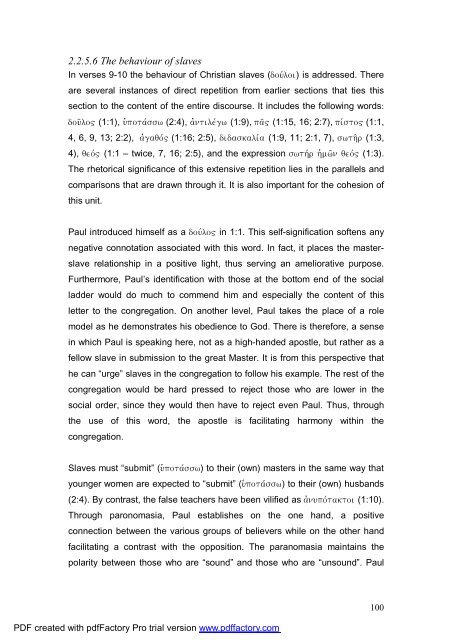A Text centred rhetorical analysis of Paul's Letter to Titus
A Text centred rhetorical analysis of Paul's Letter to Titus
A Text centred rhetorical analysis of Paul's Letter to Titus
You also want an ePaper? Increase the reach of your titles
YUMPU automatically turns print PDFs into web optimized ePapers that Google loves.
2.2.5.6 The behaviour <strong>of</strong> slaves<br />
In verses 9-10 the behaviour <strong>of</strong> Christian slaves (douvloi) is addressed. There<br />
are several instances <strong>of</strong> direct repetition from earlier sections that ties this<br />
section <strong>to</strong> the content <strong>of</strong> the entire discourse. It includes the following words:<br />
dou`lo" (1:1), uJpotavssw (2:4), ajntilevgw (1:9), pa`~ (1:15, 16; 2:7), pivs<strong>to</strong>~ (1:1,<br />
4, 6, 9, 13; 2:2), ajgaqov~ (1:16; 2:5), didaskaliva (1:9, 11; 2:1, 7), swth`r (1:3,<br />
4), qeov~ (1:1 – twice, 7, 16; 2:5), and the expression swthvr hJmw`n qeov~ (1:3).<br />
The <strong>rhe<strong>to</strong>rical</strong> significance <strong>of</strong> this extensive repetition lies in the parallels and<br />
comparisons that are drawn through it. It is also important for the cohesion <strong>of</strong><br />
this unit.<br />
Paul introduced himself as a douvlo~ in 1:1. This self-signification s<strong>of</strong>tens any<br />
negative connotation associated with this word. In fact, it places the master-<br />
slave relationship in a positive light, thus serving an ameliorative purpose.<br />
Furthermore, Paul’s identification with those at the bot<strong>to</strong>m end <strong>of</strong> the social<br />
ladder would do much <strong>to</strong> commend him and especially the content <strong>of</strong> this<br />
letter <strong>to</strong> the congregation. On another level, Paul takes the place <strong>of</strong> a role<br />
model as he demonstrates his obedience <strong>to</strong> God. There is therefore, a sense<br />
in which Paul is speaking here, not as a high-handed apostle, but rather as a<br />
fellow slave in submission <strong>to</strong> the great Master. It is from this perspective that<br />
he can “urge” slaves in the congregation <strong>to</strong> follow his example. The rest <strong>of</strong> the<br />
congregation would be hard pressed <strong>to</strong> reject those who are lower in the<br />
social order, since they would then have <strong>to</strong> reject even Paul. Thus, through<br />
the use <strong>of</strong> this word, the apostle is facilitating harmony within the<br />
congregation.<br />
Slaves must “submit” (uJpotavssw) <strong>to</strong> their (own) masters in the same way that<br />
younger women are expected <strong>to</strong> “submit” (uJpotavssw) <strong>to</strong> their (own) husbands<br />
(2:4). By contrast, the false teachers have been vilified as ajnupovtak<strong>to</strong>i (1:10).<br />
Through paronomasia, Paul establishes on the one hand, a positive<br />
connection between the various groups <strong>of</strong> believers while on the other hand<br />
facilitating a contrast with the opposition. The paranomasia maintains the<br />
polarity between those who are “sound” and those who are “unsound”. Paul<br />
PDF created with pdfFac<strong>to</strong>ry Pro trial version www.pdffac<strong>to</strong>ry.com<br />
100

















